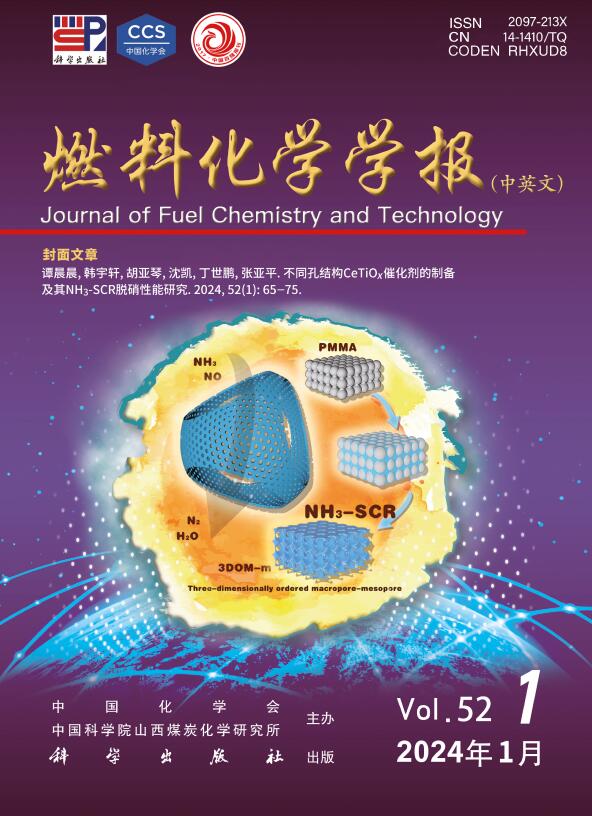Corrosion behavior of co-gasification slag of furfural residue and coal on alumina-silica refractories
Q3 Energy
引用次数: 0
Abstract
Gasification of furfural residue with coal can realize its efficient and clean utilization. But the high alkali metal content in furfural slag is easy to cause the corrosion of gasifier refractory. Two gasification coals with different silica alumina ratio and a furfural residue were selected in the study. The effects of furfural residue additions on corrosion of silica brick, corundum brick, high alumina brick and mullite brick were investigated by using XRD, SEM-EDS and Factsage Software, and the corrosion mechanism was analyzed. With increasing furfural residue addition, the permeability of the slags to high-aluminium-bearing refractories first decreases and then increases, while the permeability on silica brick shows a slight decrease trend. Leucite (KAlSi2O6) with high-melting temperature is generated from the reaction of K2O and SiO2 in slag with Al2O3 in refractories after furfural residue is added, which hinders the infiltration of slag in refractories. Kaliophilite (KAlSiO4) of low-melting point is formed when K2O content increases, and this contributes to the infiltration of slag in refractories. The acid-base reaction between slag and silica brick is distinctly occurred, more slag reacts with SiO2 in the silicon brick, resulting in a decrease in the amount of slag infiltrating into the silicon brick as furfural residue is added. The corrosion of silica brick is mainly caused by the acid-base reaction, while the corrosion of three alumina based refractory bricks of corundum, mullite and high alumina brick is determined by slag infiltration. A linear correlation between the percolation rate and slag viscosity is established, the slag permeability increases with decreasing viscosity, resulting in stronger permeability for the high Si/Al ratio slag with lower viscosity.
糠醛渣和煤在氧化铝-二氧化硅耐火材料上的共气化渣腐蚀行为
糠醛渣与煤一起气化可以实现糠醛渣的高效清洁利用。但糠醛渣中碱金属含量高,易造成气化炉耐火材料腐蚀。本研究选择了两种不同硅铝比的气化煤和一种糠醛渣。利用 XRD、SEM-EDS 和 Factsage 软件研究了糠醛渣添加量对硅砖、刚玉砖、高铝砖和莫来石砖腐蚀的影响,并分析了腐蚀机理。随着糠醛残渣添加量的增加,炉渣对高铝耐火材料的渗透率先降低后升高,而对硅砖的渗透率则呈轻微下降趋势。加入糠醛渣后,炉渣中的 K2O 和 SiO2 与耐火材料中的 Al2O3 反应生成了熔融温度较高的褐铁矿(KAlSi2O6),阻碍了炉渣在耐火材料中的渗透。当 K2O 含量增加时,会形成低熔点的 Kaliophilite(KAlSiO4),这有助于炉渣在耐火材料中的渗透。炉渣与硅砖之间发生明显的酸碱反应,更多的炉渣与硅砖中的 SiO2 发生反应,导致渗入硅砖中的炉渣量随着糠醛渣的加入而减少。硅砖的腐蚀主要是由酸碱反应引起的,而刚玉砖、莫来石砖和高铝砖这三种氧化铝基耐火砖的腐蚀则是由炉渣渗入决定的。渗流率与炉渣粘度之间呈线性关系,炉渣渗透性随粘度的降低而增加,粘度较低的高硅/铝比炉渣的渗透性更强。
本文章由计算机程序翻译,如有差异,请以英文原文为准。
求助全文
约1分钟内获得全文
求助全文
来源期刊

燃料化学学报
Chemical Engineering-Chemical Engineering (all)
CiteScore
2.80
自引率
0.00%
发文量
5825
期刊介绍:
Journal of Fuel Chemistry and Technology (Ranliao Huaxue Xuebao) is a Chinese Academy of Sciences(CAS) journal started in 1956, sponsored by the Chinese Chemical Society and the Institute of Coal Chemistry, Chinese Academy of Sciences(CAS). The journal is published bimonthly by Science Press in China and widely distributed in about 20 countries. Journal of Fuel Chemistry and Technology publishes reports of both basic and applied research in the chemistry and chemical engineering of many energy sources, including that involved in the nature, processing and utilization of coal, petroleum, oil shale, natural gas, biomass and synfuels, as well as related subjects of increasing interest such as C1 chemistry, pollutions control and new catalytic materials. Types of publications include original research articles, short communications, research notes and reviews. Both domestic and international contributors are welcome. Manuscripts written in Chinese or English will be accepted. Additional English titles, abstracts and key words should be included in Chinese manuscripts. All manuscripts are subject to critical review by the editorial committee, which is composed of about 10 foreign and 50 Chinese experts in fuel science. Journal of Fuel Chemistry and Technology has been a source of primary research work in fuel chemistry as a Chinese core scientific periodical.
 求助内容:
求助内容: 应助结果提醒方式:
应助结果提醒方式:


